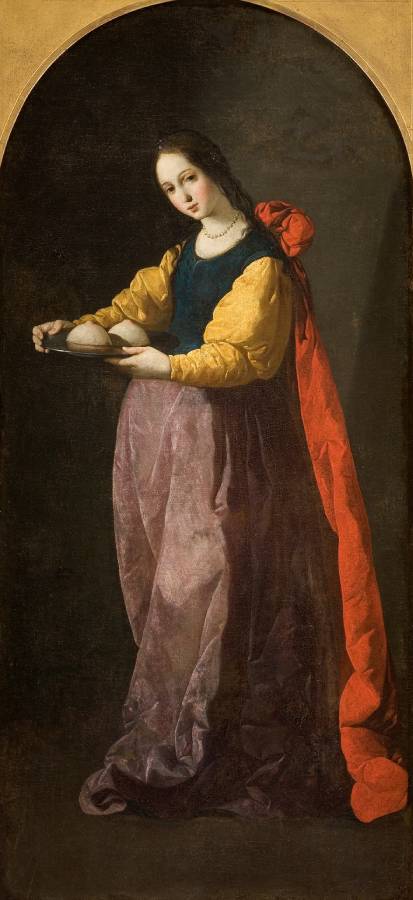Zurbarán, Francisco de (1598-1664)
Santa Águeda (Saint Agatha)
c.1635–1640
Oil on canvas, 129 × 61 cm
Musée Fabre, Montpellier
The prefect Quintianus wants to marry the beautiful and noble Sicilian Agathe; having dedicated her life to Christ, she refuses. So he makes her squeeze her breasts. This work and a Saint Ferdinand (Saint Petersburg museum) belonged to the same Sevillian altarpiece of a still uncertain location.
The famous Saint Agatha from the Fabre museum, one of the jewels of the collection, has continued to fascinate visitors since its purchase by the city in 1852 at the Soult sale, at the same time as L’Ange Gabriel. In all likelihood the painting comes from the convent of Merced Calzada, dismembered during the occupation of Seville by the French in 1810.
Agathe, great saint of the Counter-Reformation, was honored very early in Spain. Originally from Catania, the beautiful and rich Agathe decided to devote her life to Christ from her earliest childhood. She resists the advances of the pagan prefect Quintianus and undergoes atrocious tortures – breasts crushed then sliced – while proclaiming her faith. Of the many saints represented by Zurbarán, Saint Agatha is undoubtedly the most fascinating and mysterious. She is shown standing, her body slightly bent, her face turned towards the viewer, presenting the sinister trophy in the style of the Herodias or Salome dear to the Caravaggio world. The gesture is both humble and delicate. The graceful expression is tinged with melancholy.
The completely abstract composition skillfully plays on the play of round and curved shapes. The chiaroscuro enhances the beautiful tactile materials in a range of rare and daring colors: duck blue of the leotard, mauve of the dress turning to amaranth, red of the coat, luminous yellow of the sleeves – the famous “citrine sleeves” which enchanted Paul Valéry. It is this mixture of stylization, reverie, combined with the realism of the color and certain details such as the breasts with milky reflections placed on the metal tray, which gives all the haunting charm of this painting created around 1635–1640, truly icon of religious painting from the Spanish Golden Age. (FABRE)
